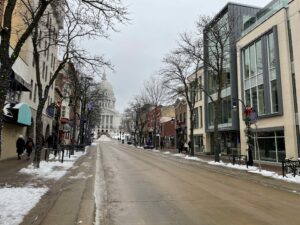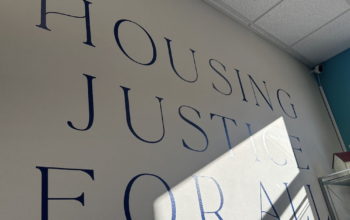If someone were to get on stage and announce that they stole your wallet — they wanted to acknowledge that they stole your wallet and spent your money — you might think you’d get your wallet back.
This is how Justice Castañeda, executive director of Common Wealth Development, views land acknowledgements, written or spoken acknowledgments recognizing the Native people who resided on any given land prior to the arrival of white colonizers.
In a city with constant construction of housing developments and rapid population growth, there remains an energetic movement towards historical preservation. With residents and admirers of some of the city’s geographically gorgeous neighborhoods, such as Mansion Hill and the First Settlement historic district, playing prominent roles in this campaign, there remain many questions about whose history the preservationists are working to salvage or honor.
At the core of their work is a key question: At what point does the history of the land that is now Wisconsin begin?
“Whose history are we trying to preserve?” Castañeda asks.
The Madison Trust for Historic Preservation is a nonprofit organization that advocates for Madison’s historic spaces, educates people about the existing historic structures in town and recognizes people who play critical roles in historical preservation, according to board member Bob Klebba.
Klebba’s interest in historic preservation began when he bought and renovated a house in Madison that is listed on the National Register of Historic Places, and from that point on, he has been invested in preserving the character of neighborhoods and older housing.
“It’s important to recognize what we have and it’s important to recognize what we’re losing,” Klebba said.
Seemingly, this narrative of preservation conflicts with those of development, as much of what is being built is only being built with the destruction of previous structures. The trust was founded in response to the destruction in 1974 of two historic buildings, the house of William F. Vilas and the Mapleside Farmhouse, that were replaced by commercial buildings and a Burger King.
Even Klebba admits the argument for historical preservation is a bit awkward.
“We are guilty of pursuing the interests of old dead white people, and we are very aware of that identity,” Klebba said.
This isn’t to say that all historic preservation operates this way. The Historic Indian Agency House is an organization based in Portage, Wisconsin, that works to preserve and honor not only the property that Ho-Chunk people reside on, but the ongoing legacy of the Ho-Chunk nation.
Originally created to serve as an embassy between the U.S. government and the Ho-Chunk nation, the Historic Indian Agency House now functions as a museum and center for native historical preservation in Wisconsin, according to director Adam Novey.
“I think something that’s kind of overlooked in how the stories of this history have been preserved is the fact that this isn’t something that’s confined to the past,” Novey said. “The story of our site and general Native American history throughout the state is something that I think people really don’t often realize the continuing history of.”
A lot of the time, various structures are built on top of effigy mounds, sometimes with documentation and sometimes without. In regards to historical preservation, Novey said, it can be hard to grasp the concept of conserving one thing without sound documentation of what came before.
“Something can have a footprint beneath the ground. Even if it’s not still there, on the ground surface, there’s still the footprint of that beneath the ground. And that’s just as important a part of what used to be able to be seen on top of the ground,” he said.
Honesty, Novey notes, is also incredibly important within the scope of remembrance, preservation and the honoring of covered up or torn down landmarks. In a climate of consistent movement and growth, stories of the past are forgotten or purposefully left behind. Novey believes that transparency is the best way to move forward, while still honoring the past.
“I think just being able to fully tell the good, the bad, the ugly of everything that happened is something that honors everybody involved by not trying to clean up history,” Novey said.
With that in mind, Klebba believes it’s important to use what we already have to support our community. He believes that there are ways to preserve current housing while also creating affordable housing; he calls this naturally occurring affordable housing.
“There’s a lot of older houses that were never that fancy, but just got taken over by student housing because owners could make more money by making two or three apartments out of a house,” Klebba said. “So these older buildings, because of their age, become naturally occurring affordable housing.”
Preserving affordable housing is one of the many mission points of Common Wealth Developments, according to Castañeda, who doesn’t buy the idea that the city needs a boom in new luxury housing development to accommodate the rise in population.
“People say that they can’t create low income housing with that, but really, what they’re saying is that they can’t make as much money off of it, which is two separate statements,” Castañeda said.
One of the things Common Wealth does is purchase properties and hold onto them as a way to create and retain affordable rental housing for low-income individuals in Madison. Castañeda notes that historical preservation can often get in the way of the way they run these buildings by making it rather expensive to renovate and make them liveable if the building is any kind of historic landmark.
“The rest of Madison has a romantic nostalgia for a history of segregation; I don’t have such nostalgia for these things,” Castañeda said. “I think there’s been some efforts to really preserve and tell the story of Black Madison. Recently, in the last 15 to 20 years, we have more folks of color in prominent positions today than we probably did 30 years ago. So with that has come a renewed emphasis on really thinking about the multidimensional history of Madison.”
This goes to show that historical preservation goes much beyond the preservation of old buildings.Along with this preservation of older buildings comes the history of the time periods in which they were built and the people that lived in them.
“I think when you think about honoring our history, if that history is one of subjugation and or exclusion, the way to honor that is to fundamentally reshape it,” Castañeda said.
Similarly, Novey believes that the need for historical preservation can’t be a priority until we are able to understand how we want to honor our full past in the future.
“We can’t really move forward as a community until we understand our past, and the preservation [of our] past is an important part of that,” Novey said. “It’s about keeping history before our eyes in the present and even in the midst of other priorities.”






